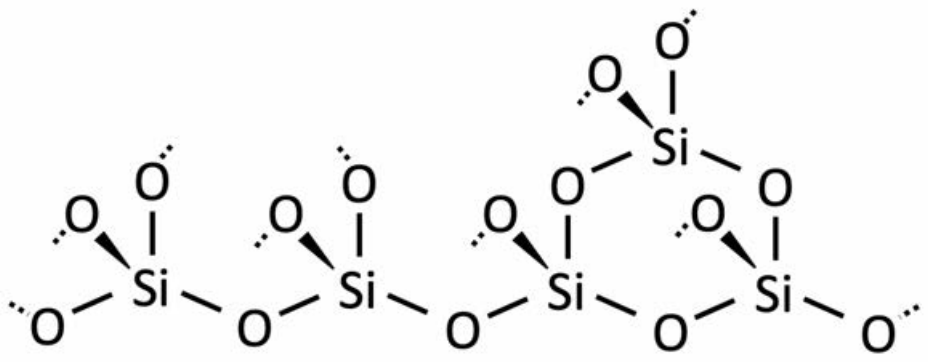6.20: Glass Formers and Network Modifiers
- Page ID
- 408862
\( \newcommand{\vecs}[1]{\overset { \scriptstyle \rightharpoonup} {\mathbf{#1}} } \)
\( \newcommand{\vecd}[1]{\overset{-\!-\!\rightharpoonup}{\vphantom{a}\smash {#1}}} \)
\( \newcommand{\id}{\mathrm{id}}\) \( \newcommand{\Span}{\mathrm{span}}\)
( \newcommand{\kernel}{\mathrm{null}\,}\) \( \newcommand{\range}{\mathrm{range}\,}\)
\( \newcommand{\RealPart}{\mathrm{Re}}\) \( \newcommand{\ImaginaryPart}{\mathrm{Im}}\)
\( \newcommand{\Argument}{\mathrm{Arg}}\) \( \newcommand{\norm}[1]{\| #1 \|}\)
\( \newcommand{\inner}[2]{\langle #1, #2 \rangle}\)
\( \newcommand{\Span}{\mathrm{span}}\)
\( \newcommand{\id}{\mathrm{id}}\)
\( \newcommand{\Span}{\mathrm{span}}\)
\( \newcommand{\kernel}{\mathrm{null}\,}\)
\( \newcommand{\range}{\mathrm{range}\,}\)
\( \newcommand{\RealPart}{\mathrm{Re}}\)
\( \newcommand{\ImaginaryPart}{\mathrm{Im}}\)
\( \newcommand{\Argument}{\mathrm{Arg}}\)
\( \newcommand{\norm}[1]{\| #1 \|}\)
\( \newcommand{\inner}[2]{\langle #1, #2 \rangle}\)
\( \newcommand{\Span}{\mathrm{span}}\) \( \newcommand{\AA}{\unicode[.8,0]{x212B}}\)
\( \newcommand{\vectorA}[1]{\vec{#1}} % arrow\)
\( \newcommand{\vectorAt}[1]{\vec{\text{#1}}} % arrow\)
\( \newcommand{\vectorB}[1]{\overset { \scriptstyle \rightharpoonup} {\mathbf{#1}} } \)
\( \newcommand{\vectorC}[1]{\textbf{#1}} \)
\( \newcommand{\vectorD}[1]{\overrightarrow{#1}} \)
\( \newcommand{\vectorDt}[1]{\overrightarrow{\text{#1}}} \)
\( \newcommand{\vectE}[1]{\overset{-\!-\!\rightharpoonup}{\vphantom{a}\smash{\mathbf {#1}}}} \)
\( \newcommand{\vecs}[1]{\overset { \scriptstyle \rightharpoonup} {\mathbf{#1}} } \)
\( \newcommand{\vecd}[1]{\overset{-\!-\!\rightharpoonup}{\vphantom{a}\smash {#1}}} \)
\(\newcommand{\avec}{\mathbf a}\) \(\newcommand{\bvec}{\mathbf b}\) \(\newcommand{\cvec}{\mathbf c}\) \(\newcommand{\dvec}{\mathbf d}\) \(\newcommand{\dtil}{\widetilde{\mathbf d}}\) \(\newcommand{\evec}{\mathbf e}\) \(\newcommand{\fvec}{\mathbf f}\) \(\newcommand{\nvec}{\mathbf n}\) \(\newcommand{\pvec}{\mathbf p}\) \(\newcommand{\qvec}{\mathbf q}\) \(\newcommand{\svec}{\mathbf s}\) \(\newcommand{\tvec}{\mathbf t}\) \(\newcommand{\uvec}{\mathbf u}\) \(\newcommand{\vvec}{\mathbf v}\) \(\newcommand{\wvec}{\mathbf w}\) \(\newcommand{\xvec}{\mathbf x}\) \(\newcommand{\yvec}{\mathbf y}\) \(\newcommand{\zvec}{\mathbf z}\) \(\newcommand{\rvec}{\mathbf r}\) \(\newcommand{\mvec}{\mathbf m}\) \(\newcommand{\zerovec}{\mathbf 0}\) \(\newcommand{\onevec}{\mathbf 1}\) \(\newcommand{\real}{\mathbb R}\) \(\newcommand{\twovec}[2]{\left[\begin{array}{r}#1 \\ #2 \end{array}\right]}\) \(\newcommand{\ctwovec}[2]{\left[\begin{array}{c}#1 \\ #2 \end{array}\right]}\) \(\newcommand{\threevec}[3]{\left[\begin{array}{r}#1 \\ #2 \\ #3 \end{array}\right]}\) \(\newcommand{\cthreevec}[3]{\left[\begin{array}{c}#1 \\ #2 \\ #3 \end{array}\right]}\) \(\newcommand{\fourvec}[4]{\left[\begin{array}{r}#1 \\ #2 \\ #3 \\ #4 \end{array}\right]}\) \(\newcommand{\cfourvec}[4]{\left[\begin{array}{c}#1 \\ #2 \\ #3 \\ #4 \end{array}\right]}\) \(\newcommand{\fivevec}[5]{\left[\begin{array}{r}#1 \\ #2 \\ #3 \\ #4 \\ #5 \\ \end{array}\right]}\) \(\newcommand{\cfivevec}[5]{\left[\begin{array}{c}#1 \\ #2 \\ #3 \\ #4 \\ #5 \\ \end{array}\right]}\) \(\newcommand{\mattwo}[4]{\left[\begin{array}{rr}#1 \amp #2 \\ #3 \amp #4 \\ \end{array}\right]}\) \(\newcommand{\laspan}[1]{\text{Span}\{#1\}}\) \(\newcommand{\bcal}{\cal B}\) \(\newcommand{\ccal}{\cal C}\) \(\newcommand{\scal}{\cal S}\) \(\newcommand{\wcal}{\cal W}\) \(\newcommand{\ecal}{\cal E}\) \(\newcommand{\coords}[2]{\left\{#1\right\}_{#2}}\) \(\newcommand{\gray}[1]{\color{gray}{#1}}\) \(\newcommand{\lgray}[1]{\color{lightgray}{#1}}\) \(\newcommand{\rank}{\operatorname{rank}}\) \(\newcommand{\row}{\text{Row}}\) \(\newcommand{\col}{\text{Col}}\) \(\renewcommand{\row}{\text{Row}}\) \(\newcommand{\nul}{\text{Nul}}\) \(\newcommand{\var}{\text{Var}}\) \(\newcommand{\corr}{\text{corr}}\) \(\newcommand{\len}[1]{\left|#1\right|}\) \(\newcommand{\bbar}{\overline{\bvec}}\) \(\newcommand{\bhat}{\widehat{\bvec}}\) \(\newcommand{\bperp}{\bvec^\perp}\) \(\newcommand{\xhat}{\widehat{\xvec}}\) \(\newcommand{\vhat}{\widehat{\vvec}}\) \(\newcommand{\uhat}{\widehat{\uvec}}\) \(\newcommand{\what}{\widehat{\wvec}}\) \(\newcommand{\Sighat}{\widehat{\Sigma}}\) \(\newcommand{\lt}{<}\) \(\newcommand{\gt}{>}\) \(\newcommand{\amp}{&}\) \(\definecolor{fillinmathshade}{gray}{0.9}\)Glass formers
In \(3.091\), we focus on silica glass. The chemical composition of silica is \(\mathrm{SiO}_2\): you are now well equipped to check this compound is charge-neutral. Although the charges are balanced, if you were to draw a Lewis dot diagram for \(\mathrm{SiO}_2\), you might notice that there are lots of lone pairs of electrons that aren't involved in bonding. You may also recall that silicon, with its four valence electrons, typically forms tetrahedrally coordinated (or \(\mathrm{sp}^3\) ) bonds. What ends up happening when liquid silica solidifies is that oxygen atoms are shared between silicon atoms, acting like bridges: these are referred to as bridging oxygens. If we were to flatten crystalline silica to represent it in 2D, it might look something like this (not a true projection):

Here, the dotted lines represent half-bonds that would continue on throughout \(3 \mathrm{D}\) space. Each oxygen atom is a bridging oxygen, because it is shared between adjacent silicon atoms. Though the stoichiometry is \(\mathrm{SiO}_2\), you can think of the tetrahedral structure as silicate groups \(\left(\left[\mathrm{SiO}_4\right]^{4-}\right)\) where the oxygen ions are then shared with neighboring \(\mathrm{Si}\) ions, yielding a charge-neutral compound.
\(\mathrm{Si}+4\left(\dfrac{1}{2} \mathrm{O}\right)=\mathrm{Si}+2 \mathrm{O}=\mathrm{SiO}_2\)
Although I've shown a crystalline representation above, the same concept applies for glasses: the difference is that in a glass, the arrangement of the bonds is not perfectly tetrahedral. In lecture and in Recitation 19 , we we talked about various processing methods that yield more disordered (glassy) or more ordered (crystalline) materials. Generally, when a glass forms instead of a crystal, the bonds do not have enough time (or energy) to become arranged in neat tetrahedrons: instead, they are rotated, stretched, and the long range structure is generally amorphous. The chemistry, however, remains the same: for silica glass, there are bridging oxygen atoms that connect neighboring silicon atoms, and a 2:1 ratio of oxygen atoms to silicon atoms. The resulting glass is like a large network of haphazardly-arranged \(\mathrm{Si}-\mathrm{O}\) bonds: for this reason, silica is called a network former.
Network modifiers
In contrast to a network former, there can also be network modifiers: elemental defects introduced into the melt that disrupt the highly connected silica network. Some examples include \(\mathrm{Na}_2 \mathrm{O}, \mathrm{CaO}_2\) and \(\mathrm{Al}_2 \mathrm{O}_3\). These ionic oxides dissociate inside the glass, and the strongly electropositive cations have an affinity for the electronegative oxygen atoms. Here's an example using \(\mathrm{Na}_2 \mathrm{O}\):
Let's focus in on one bridging oxygen. If we think of it like a chemical reaction, we can add a number of units of \(\mathrm{Na}_2 \mathrm{O}\).

Each \(\mathrm{Na}_2 \mathrm{O}\) in the melt dissociates into two sodium atoms and an oxygen atom. One of the covalent bonds connecting the bridging oxygen atom is broken by the sodium atoms. Of course, mass is conserved, and the oxygen from \(\mathrm{Na}_2 \mathrm{O}\) can form a new covalent bond with the \(\mathrm{Si}\) whose bond was broken. In the final state, the \(\mathrm{Na}^{+}\) atoms form ionic bonds with the newly nonbridging oxygen atoms. The network of silica has been split.

For other ionic salts, you can think of each \(\mathrm{O}_2^{2-}\) that is added as breaking one bond, but creating two nonbridging oxygen atoms. The more network modifier that is added, the more this process happens, and the shorter the continuous chains of silica get! As the chains get shorter and shorter, they can slide past each other more easily during cooling. It's harder for them to get tangled. Therefore, the more network modifier is added, the lower the free volume of the glass that results (holding all other factors constant), because the shorter chains can pack more efficiently than the jumbled mess of pure silica glass.
Example: Sketch a glass cooling curve comparing a glass with a lot of network modifier added to a glass with little network modifier added, assuming the cooling rate is the same for both.
- Answer
-

Note that the glass with more network modifier has a lower \(\mathrm{T}_g\)!

